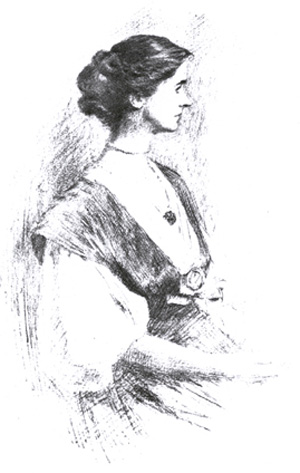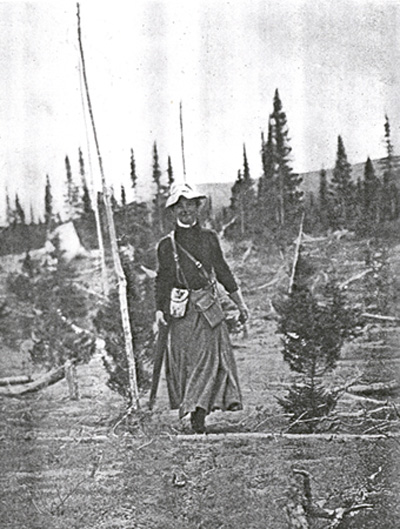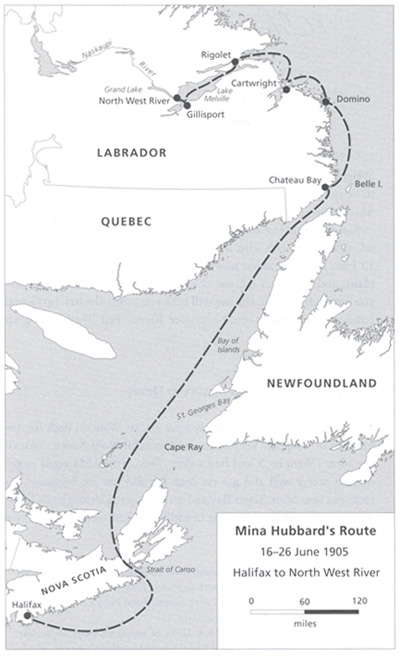|
Sherrill Grace,
"Inventing Mina Benson Hubbard: From her 1905 Expedition
across Labrador to her 2005 Centennial (and Beyond)"
(page 2 of 7)
Mina hired George Elson, who was of Cree/Scots descent, to be her
chief guide and together with three experienced native men they left the
tiny fur-trading post of Northwest River, Labrador, in June 1905 to make
the six-hundred-mile trip through the interior and north to the George
River post on Ungava Bay. This well educated, white, middle-class, very
attractive widow of thirty-five, set out alone, with four non-white men,
on a journey that would take her far away from all the watchful eyes,
constraints, prejudices, and taboos of her society. She would be out of
sight (notably by white eyes) for almost seven weeks. However, the Mina
Benson Hubbard—elegant, ladylike, demure—as she was depicted in the 1907
portrait by Joseph Sydall (see Illustration 2), was the same person as the
happy, free, active woman who strides towards the camera on her Labrador
trail in the summer of 1905 (see Illustration 3). Both images were reproduced
in her book, and when I reflect on these two images I wonder who the
real Mina was and how the free spirit on her Labrador trail managed to
squeeze herself back into the corseted, decorous lady. It was
reflecting on such apparent contradictions that caused me to start
thinking about the concept of invention because the quick answer to my
question—who was the real Mina?—is that there were several Minas and
that she herself discovered, or invented, some of them during her
expedition. The process of invention had begun well before her book
appeared in 1908.

Illustration 2 This formal portrait of Mina Benson Hubbard
was created by British artist Joseph Syddall in 1907 and used as the
frontispiece in the Murray edition of A Woman's Way Through Unknown
Labrador. Murray also used Syddall's picture of Mina in marketing
brochures for the book, thus 'selling' her as a lady and her expedition
and book as respectable.

Illustration 3 This photograph of Mina on the trail in
Labrador in the summer of 1905 was almost certainly taken by George
Elson. Mina included it in her book.
Today Labrador is an official part of Newfoundland, the last province
to join Canada in 1949, but at the end of the 19th century it was remote
indeed, part of the British Empire, and serviced—minimally—by the
British supply ship Pelican which made one annual summer visit to
the coast and as far into Hudson Bay as Ungava. The Montagnais and
Naskaspi First Nations, now known collectively as the Innu, were
virtually untouched by white civilization, and the interior of Labrador
had been incompletely, and inaccurately, mapped by Arthur Low of the
Geological Survey of Canada. In the racist rhetoric of the day—a
rhetoric subscribed to by most northern explorers but not by Mina—these
tribes and their way of life were objects of curiosity, the stuff upon
which to make a reputation, stone age people for white men from the
south to discover. One of the key reasons for the failure of
Leonidas's 1903 expedition was the map; he could only rely on Low's
partial and inaccurate cartography and he took the wrong water route.
Among the other reasons for his failure and death were his lack of
appropriate supplies and gear, an early winter, and an unwillingness to
listen to the advice of his non-white guide George Elson. Mina made
none of these mistakes. She set out, as Leonidas had done (and as
Dillon Wallace was doing again at exactly the same time, in June 1905),
from the Northwest River post, she found the correct river route up the
Naskapi River to Lake Michikimau and then north on the George River to
Ungava (see Illustration 4).
As she went, she took the measurements that
enabled her to redraw the map of the Labrador interior; she took
hundreds of photographs of the country, its native people, her guides,
for whom she had the utmost respect, and their expedition work; and she
wrote almost daily in her journal. She did not have to do any of the
heavy, dangerous work of poling, packing on portages, or paddling, but
after her return unknown Labrador was unknown no longer.
Contemporary maps of Labrador and Atlantic Canada provide some sense of
how the area looks now (see Hart et al); however, a mere map cannot
capture the significant changes that have been made from the time of
WWII to the present by white settlers, developers, and politicians.

Illustration 4 Mina published this version of her map of
Labrador with one of her articles. On it she indicates her correct
route running north of A.P. Low's mistaken mapping of the river.
Mina would go on inventing herself after her return from Labrador by
giving public lectures, writing essays—scientific and popular—and
publishing her book. She remarried in England, raised three children
and worked for the suffragette movement; she returned to Canada
frequently and once, in her sixties, traveled north for a reunion with
George Elson. Labrador had become part of her, as the announcement for
a 1938 lecture indicates: the lecture, given at today's University of
Guelph was part of a tour she undertook that year and she is described
in the advertising as a Fellow of the Royal Geographical Society and as
the successful explorer of Labrador (see Hart, 411). According to her
children, she was an austere presence who would regularly set forth on
long walks by announcing that she was going off to explore, and it was
on the last of these explorations that she was struck and killed by a
train, not far from her home in England, at age eighty-six. Today a
commemorative plaque has been erected beside the road in front of the
original Ontario farmstead where she was born and grew up, but that is
only one visible reminder of who she was.
Page: 1 | 2 | 3 | 4 | 5 | 6 | 7
Next page
|